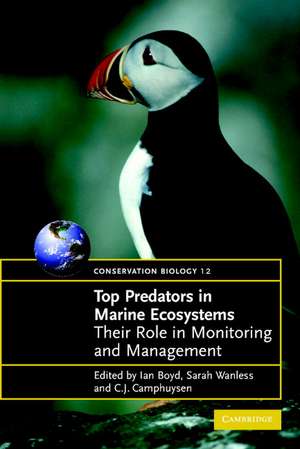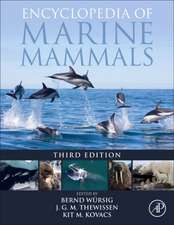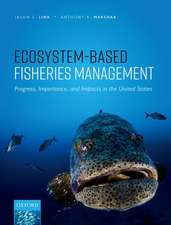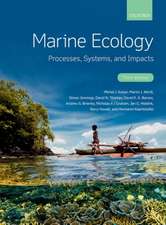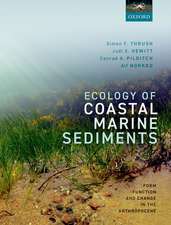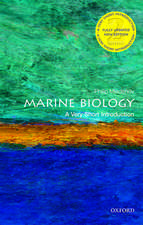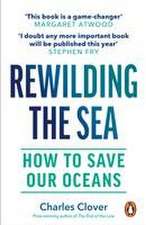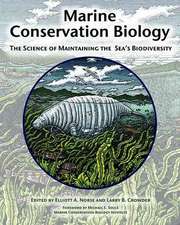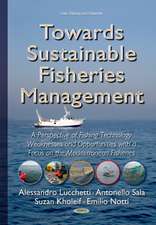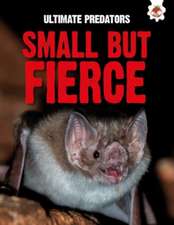Top Predators in Marine Ecosystems: Their Role in Monitoring and Management: Conservation Biology, cartea 12
Editat de I. L. Boyd, S. Wanless Autor C. J. Camphuysenen Limba Engleză Paperback – 10 mai 2006
Din seria Conservation Biology
- 11%
 Preț: 483.49 lei
Preț: 483.49 lei -
 Preț: 436.75 lei
Preț: 436.75 lei - 18%
 Preț: 913.45 lei
Preț: 913.45 lei - 18%
 Preț: 920.28 lei
Preț: 920.28 lei - 11%
 Preț: 518.65 lei
Preț: 518.65 lei - 15%
 Preț: 511.91 lei
Preț: 511.91 lei - 11%
 Preț: 528.62 lei
Preț: 528.62 lei - 18%
 Preț: 1185.38 lei
Preț: 1185.38 lei - 11%
 Preț: 463.78 lei
Preț: 463.78 lei - 18%
 Preț: 912.09 lei
Preț: 912.09 lei - 11%
 Preț: 608.31 lei
Preț: 608.31 lei - 14%
 Preț: 742.58 lei
Preț: 742.58 lei - 14%
 Preț: 705.48 lei
Preț: 705.48 lei - 11%
 Preț: 518.05 lei
Preț: 518.05 lei - 11%
 Preț: 511.84 lei
Preț: 511.84 lei - 15%
 Preț: 619.61 lei
Preț: 619.61 lei - 11%
 Preț: 533.59 lei
Preț: 533.59 lei - 11%
 Preț: 606.40 lei
Preț: 606.40 lei - 14%
 Preț: 695.12 lei
Preț: 695.12 lei -
 Preț: 375.19 lei
Preț: 375.19 lei -
 Preț: 368.39 lei
Preț: 368.39 lei - 11%
 Preț: 483.84 lei
Preț: 483.84 lei - 15%
 Preț: 621.67 lei
Preț: 621.67 lei - 11%
 Preț: 512.60 lei
Preț: 512.60 lei - 18%
 Preț: 906.34 lei
Preț: 906.34 lei - 11%
 Preț: 609.62 lei
Preț: 609.62 lei - 24%
 Preț: 1145.20 lei
Preț: 1145.20 lei - 11%
 Preț: 520.93 lei
Preț: 520.93 lei - 18%
 Preț: 1192.34 lei
Preț: 1192.34 lei - 11%
 Preț: 415.20 lei
Preț: 415.20 lei - 18%
 Preț: 907.70 lei
Preț: 907.70 lei - 11%
 Preț: 578.29 lei
Preț: 578.29 lei - 24%
 Preț: 855.37 lei
Preț: 855.37 lei - 11%
 Preț: 475.14 lei
Preț: 475.14 lei
Preț: 526.55 lei
Preț vechi: 591.63 lei
-11%
Puncte Express: 790
Preț estimativ în valută:
93.14€ • 109.20$ • 81.03£
93.14€ • 109.20$ • 81.03£
Carte tipărită la comandă
Livrare economică 05-19 martie
Preluare comenzi: 021 569.72.76
Specificații
ISBN-13: 9780521612562
ISBN-10: 052161256X
Pagini: 392
Ilustrații: 85 b/w illus. 9 tables
Dimensiuni: 153 x 229 x 19 mm
Greutate: 0.63 kg
Editura: Cambridge University Press
Colecția Cambridge University Press
Seria Conservation Biology
Locul publicării:Cambridge, United Kingdom
ISBN-10: 052161256X
Pagini: 392
Ilustrații: 85 b/w illus. 9 tables
Dimensiuni: 153 x 229 x 19 mm
Greutate: 0.63 kg
Editura: Cambridge University Press
Colecția Cambridge University Press
Seria Conservation Biology
Locul publicării:Cambridge, United Kingdom
Cuprins
Preface; 1. Introduction I. L. Boyd, S. Wanless and C. J. Campheysen; 2. Effects of fisheries on ecosystems: just another top predator? Andrew W. Trites, Villy Christensen and Daniel Pauly; 3. Physical forcing in the southwest Atlantic: ecosystem control P. N. Trathan, E. J. Murphy, J. Forcada, J. P. Croxall, K. Reid and S. E. Thorpe; 4. The use of biologically meaningful oceanographic indices to separate the effects of climate and fisheries on seabird breeding success B. E. Scott, J. Sharples, S. Wanless, O. Ross, M. Frederiksen and F. Daunt; 5. Linking predator foraging behaviour and diet with variability in continental shelf ecosystems: grey seals of eastern Canada W. D. Bowen, C. A. Beck, S. J. Iverson, D. Austin, and J. I. McMillan; 6. Distribution and foraging interactions of seabirds and marine mammals in the North Sea: multi-species foraging assemblages and habitat-specific feeding strategies. C. J. Camphuysen, Beth Scott and Sarah Wanless; 7. Spatial and temporal variation in the diets of polar bears across the Canadian Arctic: indicators of changes in prey populations and environment Sara J. Iverson, Ian Stirling, and Shelley L. C. Lang; 8. Biophysical influences on seabird trophic assessments W. A. Montevecchi, S. Garthe and G. K. Davoren; 9. Consequences of prey distribution for the foraging behaviour of top predators Iain J Staniland, Phil Trathan and Anthony R. Martin; 10. Identifying drivers of change; did fisheries play a role in the spread of North Atlantic fulmars? Paul M. Thompson; 11. Monitoring predator-prey interactions using multiple predator species: the South Georgia experience J. P. Croxall; 12. Impacts of oceanography on the foraging dynamics of seabirds in the North Sea F. Daunt, S. Wanless, G. Peters, S. Benvenuti, J. Sharples, D. Grémillet and B. Scott; 13. Foraging energetics of North Sea birds confronted with fluctuating prey availability M. R. Enstipp, F. Daunt, S. Wanless, E. M. Humphreys, K. C. Hamer, S. Benvenuti and D. Grémillet; 14. How many fish should we leave in the sea for seabirds and marine mammals? Robert W. Furness; 15. Does the prohibition of industrial fishing for sandeels have any impact on local gadoid populations? Simon P. R. Greenstreet; 16. Use of gannets to monitor prey availability in the NE Atlantic Ocean: colony size, diet and foraging behaviour Keith C. Hamer, Sue Lewis, Sarah Wanless, Richard A. Phillips, Tom N. Sherratt, Elizabeth M. Humphreys, Janos Hennicke and Stefan Garthe; 17. Population dynamics of Antarctic krill Euphausia superba at South Georgia - sampling with predators provides new insights K. Reid, E. J. Murphy, J. P. Croxall and P. N. Trathan; 18. The functional response of generalist predators and its implications for the monitoring of marine ecosystems Christian Asseburg, John Harwood, Jason Matthiopoulos and Sophie Smout; 19. The method of multiple hypotheses and the decline of Steller Sea Lions in western Alaska Nicholas Wolf, Jason Melbourne and Marc Mangel; 20. Modelling the behaviour of individuals and groups of animals foraging in heterogeneous environments J. G. Ollason, J. M. Yearsley, K. Liu and N. Ren; 21. The scenario Barents Sea study: a case of minimal realistic modelling to compare management strategies for marine ecosystems Tore Schweder; 22. Setting management goals using information from predators Andrew J. Constable; 23. Marine reserves and higher predators Sascha K. Hooker; 24. Marine management: can objectives be set for marine top predators? Mark L. Tasker.
Recenzii
'Each section of the volume has an extensive bibliography which may be one of its most valuable contents allowing an easy access to the many published sources on the subject. It is indexed in a detailed fashion and will be a valuable addition to a botanical library… an invaluable contribution to the marine conservation literature … I would strongly recommend this book to all biologists to rectify any imbalance that may have occurred in their scientific education' Biologist
' … an interesting and important book … packed with scientific knowledge …' Fish and Fisheries
' … an interesting and important book … packed with scientific knowledge …' Fish and Fisheries
Notă biografică
Descriere
An examination of how studying marine predators can identify changes in and help manage marine ecosystems.
